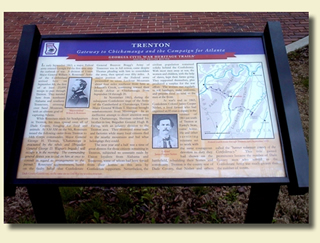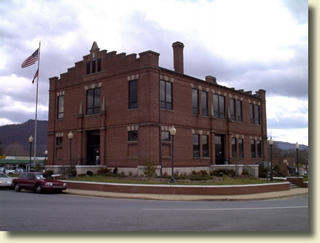The
city of Trenton, located on Highway 11, is the county seat
of Dade County Georgia. This area is shown on the New Home,
GA/AL/TN quadrangle (101-SE) of the U.S. Geological Survey
maps.
HISTORICAL
SIGNIFICANCE
Shortly after the creation of Dade County, on December 21,
1840, the Georgia Legislature made the town of Salem the
county seat of the county. The same act incorporated the
town, giving it five commissioners to be elected by the
people. The following year, due to some churches and camp
grounds using the name "Salem," the Legislature acted to
change the name of the town to Trenton. The old name went
to the New Salem community on top of Lookout Mountain. On
the eve of the war, in 1860, Trenton was a rapidly growing
and prosperous community.
As the county seat of Dade County, Trenton became a landmark
and an objective of General William Rosecrans when he moved
the Federal Army of the Cumberland toward Chattanooga in
the summer of 1863. Two divisions of General Thomas' 14th
Army Corps, commanded by Generals Reynolds and Brannan,
entered Dade County by way of Murphy's Hollow and moved
to Trenton. General Philip Sheridan's division of General
McCook's 20th Army Corps also came by Trenton.

Campaign
Trail Marker at Trenton.
The
first marker on the Chickamauga Campaign Trail at the Veteran's
Memorial Park west of the Court House at Trenton, Geroga.
On September 6th, General Rosecrans set up his headquarters
in Trenton. The general and his staff occupied the Emanuel
Mann house in the town. "General Rosecrans headquarters
came up [to Trenton] tonight," wrote Private William Bluffton
Miller, of K Company, 75th Indiana Infantry Regiment, "Trenton
is a small town and is almost deserted. It is in Lookout
Valley. The country surrounding the town is level but mountains
any way I look. I don't think I would want to live in this
country as I can not get out without climbing. If we should
have to retreat, we could hold some of the places in our
rear."
General Sheridan's division came over Sand Mountain and
also passed through Trenton. "At 10:15 A.M. we resumed our
march," one of his men wrote, "and passed through the little
village of Trenton. Eight or ten houses, besides an ordinary
court-house, was all the town contained. From Trenton we
passed on, going directly southward up the valley two miles;
our brigade in front, and the 73rd [Illinois Infantry] in
front of the brigade."
General
James Negley described Trenton as follows: "Trenton is situated
in Lookout Valley, Dade County, Georgia, a rich agricultural
district; 25 miles long and two miles wide. Forage an farm
products in abundance A small creek runs through Trenton.
The village is small, about 100 tenements and 300 souls."
On September 7,1863, 1st Lieutenant Edward W. Williams,
100th Indiana Infantry Regiment, wrote: Trenton "has two
churches, three stores, courthouse, mill, and blacksmith
shop We captured the [railroad] station, one hundred bushels
of fine salt, belonging to the state of Georgia, and intended
for distribution among the families of the [Confederate]
soldiers."
|

The Dade County Court House in Trenton, Georgia.
On the same day, Lieutenant A. Piatt Andrew, III, of the 21st
Indians Artillery Battery, wrote a letter to his sister Weck.
"You have noticed that we are no longer in Tennessee," he
pointed out. "Last Tuesday we crossed the [Tennessee] river
at Shellmoud and Thursday crossed the mountain and yesterday
entered Trenton. It is a small plce some fifteen or twenty
miles southwest of Chattanooga. When and where we next move
someone must tell you who knows, for I don't. Rebel citizens
say we are gone up,' that Bragg will capture us all, etc.,
but we think they are slightly mistaken I was out in the country
this morning looking for horses, but I was not very successful,
only finding one horse which would be of any service. The
citizens have run their horses in the mountains. Hence the
show is very poor General Rosy' is in town. We will leave
soon, I think."
The next day, September 8, 1863, Private Solomon M. Deacon,
Company K of the 87th Indian Infantry Regiment, wrote a letter
to his sister, Sallie: "We are no in camp within 10 miles
of Chattanooga in a southwesterly direction, and near Trenton,
the county seat of Dade County. I was at Trenton yesterday,
and such a county town was never seen in the Northern states.
There was but ten or twelve houses in the town and but tow
or three of them of any respectability, but it corresponds
with the surrounding country and abominable institutions of
the Confederacy. Desolation seems to be the fate of this country
and in that channel it seems fast to be wending its way."
By September 10, 1863, Chattanooga had been occupied by General
Crittenden's 21st Army Corps, and during the afternoon General
Rosecrans moved his headquarters from Trenton to Chattanooga.
Reynolds and Brannon's divisions marched south from Trenton
to cross Lookout Mountain at Johnson's Crook with the rest
of the Federal Army. In the Battle of Chickamauga on September
19 and 20, 1963, Rosecrans was badly defeated by the Confederate
Army. The Federals withdrew to Chattanooga and the siege of
that city began.
When General William T. Sherman was bringing his Army of the
Tennessee to relieve the siege of Chattanooga in November
1863, he wanted, in so far as possible, to deceive the Confederates
as to his true route and purpose. To this end he sent his
brother in law, General Hugh Ewing, with a division, to invade
Dade County from Bridgeport. Ewing's instructions were to
light numerous fires and create such a disturbance that the
Confederates would think that Sherman was bringing his entire
army in that direction with the intention of striking the
Confederates by moving up Lookout Mountain and Rosecrans had
earlier done. In the meantime, while the Confederates were
thus distracted, he would bring the army directly to Brown's
Ferry by way of Whiteside.
Colonel James Cooper Nisbet had returned to Dade County for
a visit to his home at the same time General Ewing's Federals
came off Sand Mountain. "As I rode into Trenton," he later
wrote, "I saw two old citizens watching a signal flag that
was being waved in the White Oak Gap on Sand Mountain opposite
the town. After greetings, they asked me if I knew what that
flag meant, and said they had heard that morning that there
was a force of Yanks advancing from Bridgeport, Alabama, which
had camped on Sand Mountain the previous night. While we were
talking, a regiment of cavalry was seen in the gap. They wound
down the mountain road, and then a Battery appeared, halted
and planted a gun on an open bench, and directly a shell came
shrieking over us. I was cut off from going home via the valley
road. I watched a blue regiment of cavalry until they reached
the outskirts of the town."
|
General
Ewing carried out his instructions well. He made his headquarters
in Trenton, and sent detachments out all around the county
to burn and pillage. On November 22, Confederate General Stevenson
reported from Lookout Mountain: "No report from scout sent
to Trenton. Cavalry ordered there last night. The enemy burned
some houses in the night, and I think left at [the] same time."
A
refugee from Dade County went to Athens, Georgia, and provided
an account of the destruction of Trenton to the editor of
the Athens Southern Banner. "We learn the following from a
gentleman, citizen of Dade County: The Court House and jail
were burned a short time previous to the Missionary Ridge
fight, by order of Gen. Grant [actually General Hugh Ewing
of Sherman's Corps], who was there at the time. Our informant
says the town of Trenton is completely demolished. The Federals
have taken nearly all the provisions. To destitute families,
the Yanks will furnish rations provided they will take the
oath. Quite a number have taken the oath, and several men
are working for the enemy in the coal mines. Several soldiers
of our army, residents of that county, came home, and after
laying about home awhile went over to the enemy."
For
the rest of the war, there were Federal occupation forces
stationed at Chattanooga, Whiteside, and Bridgeport. These
units made frequent patrols into Dade County and to Trenton.
The extent of war time destruction, together with more recent
commercial and residential development, have been such that
today the only war time structure remaining in Trenton is
the O'Neal house on the northwest end of town.
A few years ago the local camp of the Sons of Confederate
Veterans, in conjunction with the local post of the American
Legion and the Dade County Commission, developed the Veteran's
Memorial Park on the west side of the court house. In this
park, the local camp of the Sons of Confederate Veterans have
erected a large stone monument on which is engraved the names
of every man from Dade County who served in the Confederate
Army.
References:
Official Records of the War of the Rebellion
Archive and files Chickamauga and Chattanooga National Military
Park Raymond Evans, The Civil War in Dade County
Significant
Views: The only wartime view of Trenton is the O'Neal
House described above. The Confederate Monument can be seen
at the Veteran's Memorial Park on the west side of the County
Court House.
Setting:
The setting for modern Trenton is that of a small rural town.
The court house sits in the center of the town and everything
else is centered around the town square that contains the
court house. The Veteran's Memorial Park is located on the
west side of the Court House.
Documented
Structures, Sites and Features: As was stated above, the
only wartime structure is the O'Neal House located on the
north west end of the town.
Presumed
Wartime Features: The wartime Trenton was a thriving commercial
center for the surrounding farms that was located with the
Court House near the railroad depot. There were numerous military
camps from both armies in the area.
Original
Terrain: The terrain has been much altered from road building,
as well as by commercial and residential development.
Related
Sites: O'Neal House and White Oak Gap.
|